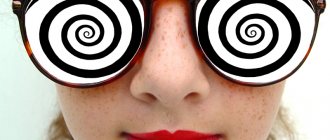Experiment in psychology (page 1 of 2)
Experiment
A psychological experiment is an experiment conducted under special conditions to obtain new scientific knowledge through the purposeful intervention of a researcher in the life activity of the subject. This is an orderly study in which the researcher directly changes a factor (or factors), holds the others constant, and observes the results of systematic changes.
Experiment as a study of variables
In a broad sense, a psychological experiment sometimes includes, in addition to the experiment itself, such research methods as observation, survey, testing). However, in a narrow sense (and traditionally in experimental psychology), an experiment is considered an independent method. .
Specifics of a psychological experiment
A psychological experiment differs in many ways from experiments in other fields of science.
In a psychology experiment it is very difficult to be sure that we are studying what we want to study.
If a chemist studies iron, he knows what he is studying. What does a psychologist study when he studies the psyche? The psyche as a construct cannot be observed objectively and its activity can only be learned based on its manifestations, for example, in the form of certain behavior.
An experimenter wants to study how lighting conditions affect work efficiency. He changes the illumination, and people react not to the amount of light, but to the fact that such a cute experimenter is next to them...
The water does not boil because it is poured into another flask. An experiment conducted on a person can influence him so strongly that the results speak more about the reaction to the experimenter and the experiment, rather than about the behavioral characteristics of a particular person. In psychological experiments, the personality of the experimenter turns out to be important: often one experimenter’s people show some results, while another’s show different results. The subject was given instructions, but how? People care about how they are treated; people react subtly to suggestions from the experimenter, which he himself may not be aware of.
Types of experiments
Psychology uses laboratory experiments, natural experiments, and formative experiments. Depending on the stage of the research, I distinguish between a pilot study and the actual experiment. Experiments can be overt or with a hidden purpose.
Many researchers practice thought experiments in the process of discussion and debate. They are obviously much cheaper and faster, although not always convincing and reliable.
According to the method of conducting experiments, experiments are distinguished:
Laboratory experiment.
This is the most common and respected experiment in scientific psychology. It allows you to control dependent and independent variables as strictly as possible.
Experiment as a study of variables
Robert Woodworth, who published his classic textbook on experimental psychology (Experimental psychology, 1938), defined an experiment as a structured study in which the researcher directly changes some factor (or factors), holds the others constant, and observes the results of systematic changes. . He considered the distinctive feature of the experimental method to be the control of the experimental factor, or, in Woodworth's terminology, the “independent variable,” and the tracking of its influence on the observed consequence, or the “dependent variable.” The experimenter's goal is to keep all conditions constant except one—the independent variable.
In a simplified example, the independent variable can be considered as a certain relevant stimulus (St(r)), the strength of which is varied by the experimenter, while the dependent variable is the reaction (R) of the subject, his psyche (P) to the influence of this relevant stimulus. Schematically this can be expressed as follows:
However, as a rule, the desired stability of all conditions, except for the independent variable, is unattainable in a psychological experiment, since almost always, in addition to these two variables, there are also additional variables, systematic irrelevant stimuli (St(1)) and random stimuli (St(2) ), leading to systematic and random errors, respectively. Thus the final schematic representation of the experimental process looks like this:
Therefore, in an experiment, three types of variables can be distinguished:
Independent variable
Dependent Variable
Additional variables (or external variables)
So, the experimenter is trying to establish a functional relationship between the dependent and independent variables, which is expressed in the function R=f(St(r)), while trying to take into account the systematic error that arose as a result of the influence of irrelevant stimuli (examples of systematic error include the phases of the moon, time of day and etc.). To reduce the likelihood of the impact of random errors on the result, the researcher seeks to conduct a series of experiments (an example of a random error could be, for example, fatigue or a speck of dust getting into the subject’s eye).
The main objective of the experimental study
The general task of psychological experiments is to establish the presence of a connection R=f(S, P) and, if possible, the type of function f (there are various types of connections - cause-and-effect, functional, correlation, etc.). In this case, R is the subject’s reaction, S is the situation, and P is the subject’s personality, psyche, or “internal processes”[3]. That is, roughly speaking, since mental processes cannot be “seen,” in a psychological experiment, based on the reaction of the subjects to stimulation regulated by the experimenter, some conclusion is made about the psyche, mental processes or personality of the subject.
Natural (field) experiment.
This is an experiment carried out in ordinary life, when there seems to be no experiment and no experimenter. See→
Formative (psychological and pedagogical) experiment.
An experiment involves a person or a group of people participating in the training and formation of certain qualities and skills. And if the result is formed, we do not need to guess what led to this result: it was this technique that led to the result. See→
Depending on the stage of the research, I distinguish between a pilot study (the so-called draft, pilot study) and the actual experiment.
Explicit and hidden experiments
Depending on the level of awareness, experiments can also be divided into
those in which the subject is given full information about the goals and objectives of the study,
those in which, for the purposes of the experiment, some information about it is hidden or distorted from the subject (for example, when it is necessary for the subject not to know about the true hypothesis of the study, he may be told a false one),
and those in which the subject is unaware of the purpose of the experiment or even the fact of the experiment itself (for example, experiments involving children).
Organization of a psychological experiment
A psychological experiment begins with instructions, or more precisely, with the establishment of certain relationships between the subject and the experimenter. Another task that the researcher faces is sampling: with whom the experiment should be conducted so that its results can be considered reliable. The end of the experiment is processing its results, interpreting the data obtained and presenting them to the psychological community.
Organization of a psychological experiment
A psychological experiment begins with instructions, or more precisely, with the establishment of certain relationships between the subject and the experimenter. Another task that the researcher faces is sampling: with whom the experiment should be conducted so that its results can be considered reliable. The end of the experiment is processing its results, interpreting the data obtained and presenting them to the psychological community.
Reliability of the experiment: validity
Validity of an experiment is the assurance that the experiment measured what the researchers intended to measure. See→
A perfect experiment
Not a single experiment in any science can withstand the criticism of supporters of the “absolute” accuracy of scientific conclusions. However, as a standard of perfection, Robert Gottsdanker introduced into experimental psychology the concept of “flawless experiment” - an unattainable ideal of an experiment that fully satisfies three criteria (ideality, infinity, complete compliance), which researchers should strive to approach. See→
Interaction between experimenter and subject
The problem of organizing the interaction between the experimenter and the subject is considered one of the main ones, generated by the specifics of psychological science. Instructions are considered the most common means of direct communication between the experimenter and the subject.
Instructions to the subject
Instructions to the subject in a psychological experiment are given in order to increase the likelihood that the subject adequately understood the experimenter's requirements, therefore it provides clear information regarding how the subject should behave and what he is asked to do. For all subjects within one experiment, the same (or equivalent) text with the same requirements is given. However, due to the individuality of each subject, in experiments the psychologist is faced with the task of ensuring an adequate understanding of the instructions by the person. Examples of differences between subjects that determine the advisability of an individual approach:
For some subjects it is enough to read the instructions once, for others - several times,
Content
- 1 Specifics of a psychological experiment
- 2 General information 2.1 The main objective of the experimental study
- 2.2 Validity in a psychological experiment
- 3.1 Depending on the method of conduct
- 4.1 The Perfect Experiment
Stages of a psychological experiment[edit]
The general model of conducting a psychological experiment meets the requirements of the scientific method. When conducting a holistic experimental study, the following stages are distinguished [8]:
- Primary statement of the problem
- Formulation of a psychological hypothesis
- Working with scientific literature
- Search for definitions of basic concepts
- Compiling a bibliography on the research topic
- Refining the hypothesis and defining variables
- Definition of experimental hypothesis
- Selecting an experimental tool that allows:
- Control the independent variable
- Log dependent variable
- Design of a pilot study
- Highlighting Additional Variables
- Selecting an Experimental Design
- Sampling and distribution of subjects into groups in accordance with the adopted plan
- Conducting an experiment
- Preparation of the experiment
- Instructing and motivating subjects
- Actually experimenting
- Statistical processing
- Selection of statistical processing methods
- Converting an experimental hypothesis into a statistical hypothesis
- Carrying out statistical processing
- Interpretation of results and conclusions
- Recording the research in a scientific report, article, monograph, letter to the editor of a scientific journal
Sources[edit]
- Nikandrov V.V.
Observation and experiment in psychology. St. Petersburg: Rech, 2002 - Research in psychology: methods and planning / J. Goodwin. St. Petersburg: Peter, 2004. P. 172.
- Zarochentsev K. D., Khudyakov A. I.
Experimental psychology: textbook. - M.: Prospekt, 2005. P. 74. - See also there. P. 51.
- Gottsdanker R.
Fundamentals of psychological experiment. M.: MGPPIA, 1982. P. 51-54. - Zarochentsev K. D., Khudyakov A. I.
Experimental psychology: textbook. P. 74. - See also there. pp. 76-77.
- Druzhinin V. N.
Experimental psychology. — 2nd ed., add. - St. Petersburg: Peter, 2002. pp. 78-85. - Zarochentsev K. D., Khudyakov A. I.
Experimental psychology: textbook. P. 50.
Recommended reading[edit]
- Zarochentsev K. D., Khudyakov A. I.
Experimental psychology: textbook. - M.: Prospekt Publishing House, 2005. ISBN 5-98032-770-3 - Research in psychology: methods and planning / J. Goodwin. — 3rd ed. - St. Petersburg: Peter, 2004. ISBN 5-94723-290-1
- Martin D. Psychological experiments.
St. Petersburg: Prime-Eurosign, 2004. ISBN 5-93878-136-1 - Nikandrov V.V.
Observation and experiment in psychology. SPb.: Rech, 2002 ISBN 5-9268-0141-9 - Solso R. L., Johnson H. H., Beal M. K.
Experimental psychology: a practical course. - SPb.: Prime-EVROZNAK, 2001.
Specifics of a psychological experiment[edit]
In psychology, experimental research has its own specificity, which allows it to be considered separately from research in other sciences. The specificity of a psychological experiment is that:
- The psyche as a construct cannot be observed objectively and its activity can only be learned based on its manifestations, for example, in the form of certain behavior.
- When studying mental processes, it is considered impossible to isolate any one of them, and the impact always occurs on the psyche as a whole (or, from a modern point of view, on the body as a single indivisible system).
- In experiments with people (as well as some higher animals, for example, primates), there is active interaction between the experimenter and the subject.
- This interaction also makes it necessary for the subject to have instructions (which, obviously, is not typical for natural science experiments).
Heinz's dilemma
Psychologist Lawrence Kohlberg studied moral development. He believed that this is a process that continues throughout life. To confirm his guesses, Kohlberg presented children of different ages with complex moral dilemmas.
The psychologist told the children a story about a woman who was dying - cancer was killing her. And by a stroke of luck, one pharmacist allegedly invented a medicine that could help her. However, he asked for a huge price - $2,000 per dose (although the cost of manufacturing the medicine was only $200). This woman's husband - his name was Heinz - borrowed money from friends and collected only half the amount, $1,000.
Article on the topic
TEST: What kind of animal are you?
Arriving at the pharmacist, Heinz asked him to sell the medicine for his dying wife cheaper, or at least on credit. However, he replied: “No! I created a cure and I want to get rich." Heinz fell into despair. What was to be done? That same night he secretly entered the pharmacy and stole the medicine. Did Heinz do a good job?
This is the dilemma. Interestingly, Kohlberg did not study the answers to the question, but the reasoning of the children. As a result, he identified several stages in the development of morality: starting from the stage when the rules are perceived as absolute truth, and ending with the observance of one’s own moral principles - even if they run counter to the laws of society.
Types of experiments[edit]
Depending on the method[edit]
There are mainly three types of experiments[4]:
- Laboratory experiment
- Field or natural experiment
- Formative or psychological and pedagogical experiment
Depending on the stage of the study[edit]
- Pilot study (so-called draft, trial study)
- The actual experiment
Depending on the level of awareness[edit]
Depending on the level of awareness, experiments can also be divided into
- those in which the subject is given full information about the goals and objectives of the study,
- those in which, for the purposes of the experiment, some information about it is hidden or distorted from the subject (for example, when it is necessary for the subject not to know about the true hypothesis of the study, he may be told a false one),
- and those in which the subject is unaware of the purpose of the experiment or even the fact of the experiment itself (for example, experiments involving children).
Invisible Gorilla
Perceptual blindness is a phenomenon when a person is so overwhelmed with impressions that he does not notice anything around him. Attention is completely absorbed by only one object. Each of us suffers from this type of visual blindness from time to time.
Article on the topic
Absent-mindedness - the ghost of genius? Exercises for concentration
Daniel Simons showed subjects a video of people wearing black and white T-shirts throwing a ball to each other. The task was simple - count the number of throws. While two groups of people were throwing a ball, a man dressed in a gorilla suit appeared in the center of the sports ground: he pounded his chest with his fists, just like a real monkey, and then calmly walked away from the field.
After watching the video, participants in the experiment were asked if they noticed anything strange on the site. And as many as 50% answered negatively: half simply did not see the huge gorilla! This is explained not only by our focus on the game, but also by the fact that we are not ready to see something incomprehensible and unexpected in ordinary life.










